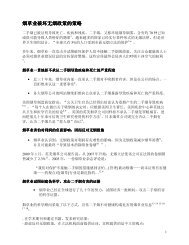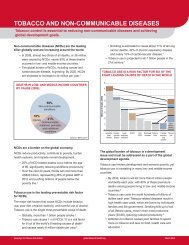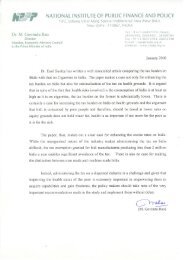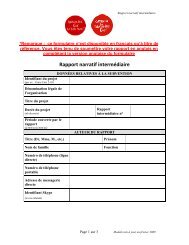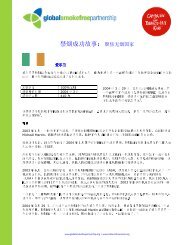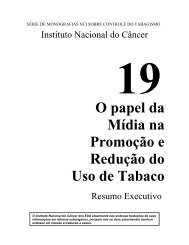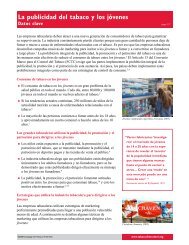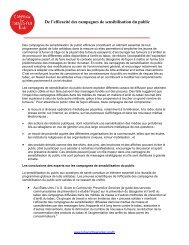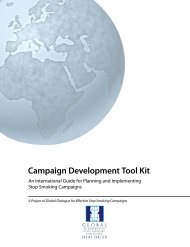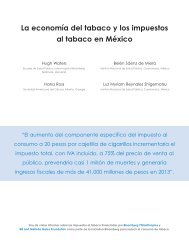Warning Labels: Essential Facts - Campaign for Tobacco-Free Kids
Warning Labels: Essential Facts - Campaign for Tobacco-Free Kids
Warning Labels: Essential Facts - Campaign for Tobacco-Free Kids
You also want an ePaper? Increase the reach of your titles
YUMPU automatically turns print PDFs into web optimized ePapers that Google loves.
<strong>Warning</strong> <strong>Labels</strong><br />
<strong>Essential</strong> <strong>Facts</strong><br />
The tobacco package is an essential communication vehicle <strong>for</strong> the tobacco<br />
industry<br />
<strong>Tobacco</strong> companies depend on package design to build brand recognition<br />
and promote sales, especially because advertising <strong>for</strong> tobacco is becoming<br />
increasingly limited in many markets.<br />
• Packaging establishes brand imagery that is often completely opposite to<br />
the realities and dangers associated with tobacco product use. 2 <strong>Tobacco</strong><br />
companies create brand imagery which promotes ideals of status, wealth,<br />
sex appeal, glamour, slimness, manhood, athleticism and health, among<br />
many others.<br />
• For the smoker, especially the teenage smoker, the tobacco product pack<br />
represents a badge that makes a statement about how he or she wants to be<br />
seen by others. 3<br />
Pictorial warning labels work!<br />
After Singapore introduced its pictorial warning labels in 2004, a Health<br />
Promotion Board survey found that 28% of smokers reported smoking fewer<br />
cigarettes because of the warnings; 14% of smokers said that they avoided<br />
smoking in front of children; 12% reported avoiding smoking in front of<br />
pregnant women; and 8% said that they smoked less at home. 4<br />
“ Our final communication<br />
vehicle with our smokers<br />
is the pack itself. In the<br />
absence of any other<br />
marketing messages,<br />
our packaging… is the<br />
sole communicator of our<br />
brand essence. Put another<br />
way: When you don’t have<br />
anything else, our packaging<br />
is our marketing.”<br />
Executive of the Phillip Morris<br />
Company, a transnational<br />
tobacco company. 1<br />
Pictorial warning labels effectively communicate the risks of tobacco use<br />
Control over cigarette packaging is critical to tobacco control ef<strong>for</strong>ts. Cigarette<br />
packs are effective mediums <strong>for</strong> broadcasting messages about the harmful<br />
impact of tobacco use. Research shows that effective warning labels increase<br />
knowledge about risks associated with smoking and can influence future<br />
decisions about smoking. 5, 6 Large and graphic warning labels can motivate<br />
smokers to quit, discourage nonsmokers from starting, 7 and keep ex-smokers<br />
from starting again. 8<br />
• 84% of smokers living in Canada, where pictorial warnings are required,<br />
saw health warning labels as a source of health in<strong>for</strong>mation, compared<br />
with 47% smokers living in the U.S. where only text labels are required. 5, 9<br />
• After Brazil introduced new pictorial warnings in 2002, 73% of smokers<br />
said they approved of them, 54% said they had changed their opinion about<br />
the health consequences of smoking, and 67% said the new warnings made<br />
them want to quit. 10<br />
• Following the introduction of Australia’s graphic health warning labels,<br />
adolescent experimental and established smokers were more likely to think<br />
about quitting, and intentions to smoke were lower among those students<br />
who discussed the new warning labels. 11<br />
<strong>Warning</strong> label, Singapore<br />
1 <strong>Warning</strong> <strong>Labels</strong>: <strong>Essential</strong> facts<br />
March 2011<br />
www.tobaccofreecenter.org
<strong>Warning</strong> <strong>Labels</strong>: <strong>Essential</strong> facts<br />
Components of an effective warning label*<br />
COMPONENT DESCRIPTION IMPACT<br />
Location<br />
Place labels on principal display areas (front<br />
and back—the largest panels of the package).<br />
Messages in prominent locations are more likely to<br />
be noticed.<br />
Size<br />
Pictorials<br />
Color,<br />
background<br />
and font<br />
Rotation<br />
Text<br />
Cover at least 50% of the package’s principal<br />
display areas.<br />
Illustrate the harmful effects of tobacco use<br />
through pictures and/or pictograms.<br />
Use full color.<br />
Contrast colors with the background and the<br />
text.<br />
Use multiple health warnings and messages<br />
on all tobacco products concurrently or rotate<br />
them periodically.<br />
List risk factors by highlighting harmful<br />
effects and impact of exposure to tobacco.<br />
Include the magnitude of specific risks.<br />
Provide cessation advice and local quit line<br />
in<strong>for</strong>mation.<br />
Identify the addictive nature of tobacco.<br />
Elicit unfavorable emotional association with<br />
tobacco use.<br />
Large messages are more likely to be noticed.<br />
Label effectiveness increases with size.<br />
Large labels provoke emotional responses and<br />
increase motivation to quit.<br />
Photos and strong graphics help smokers visualize<br />
the nature of a tobacco-caused disease better than<br />
words alone.<br />
Pictures are more likely to draw attention and are<br />
more likely to be remembered when an individual<br />
makes decisions about whether or not to smoke or<br />
cut back on smoking.<br />
Pictures are especially important in regions with<br />
low literacy or where research shows smokers are<br />
ignoring text-only warning labels.<br />
Pictorial warnings are likely to reach children and<br />
adolescents, especially the children of smokers,<br />
who are particularly vulnerable.<br />
Maximizes visibility and ease of comprehension.<br />
Prevents overexposure and the audience becoming<br />
desensitized from a single Image.<br />
Messages highlight the harmful effects of tobacco<br />
and provide important public health in<strong>for</strong>mation to<br />
the public which may not be otherwise accessible.<br />
Messages eliciting unfavorable emotional<br />
associations about tobacco use are more believable<br />
and convincing.<br />
Language Use the country’s principal language(s). Messages in all principal languages ensures a<br />
broader reach.<br />
Source<br />
attribution<br />
Label should identify a source, such as a<br />
national authority (e.g., Minister of Health)<br />
that recommends the health messages.<br />
Depending on the culture, attribution can add<br />
credibility to the message.<br />
*The components highlighted in this table are best practices derived from WHO’s FCTC Article 11 Guidelines and The <strong>Tobacco</strong> Labelling & Packaging Toolkit produced by the<br />
<strong>Tobacco</strong> Labelling Resource Centre.<br />
2 <strong>Warning</strong> <strong>Labels</strong>: <strong>Essential</strong> facts<br />
March 2011<br />
www.tobaccofreecenter.org
<strong>Warning</strong> <strong>Labels</strong>: <strong>Essential</strong> facts<br />
The World Health Organization (WHO) Framework Convention on <strong>Tobacco</strong><br />
Control (FCTC) requires effective health warning labels 12<br />
The FCTC, the world’s first global public health treaty, establishes a policy<br />
framework <strong>for</strong> reducing the devastating health and economic impacts of<br />
tobacco. Article 11 of the FCTC requires Parties to implement effective<br />
measures to warn against the harmful impact of tobacco use on all tobacco<br />
product packaging within three years after ratification. Implementation of a<br />
pictorial warning label policy presents no financial cost to governments; fees<br />
are borne by tobacco companies.<br />
<strong>Warning</strong> label, Belgium<br />
Global progress on the implementation of warning label 13<br />
Governments have made extraordinary progress in improving tobacco warning<br />
labels by implementing measures as outlined by the WHO FCTC.<br />
As of December 2010, more than 30 countries/jurisdictions have implemented<br />
graphic warning labels on tobacco packages that are a minimum of 30% of the<br />
overall package. For a more updated list of countries and details on these<br />
countries, go to http://tobaccofreecenter.org/files/pdfs/en/WL_examples_en.pdf.<br />
Key messages<br />
• The tobacco package is an essential communication vehicle <strong>for</strong> the tobacco<br />
industry; tobacco companies depend on tobacco package design to build<br />
brand recognition and promote sales. 2, 3<br />
<strong>Warning</strong> label, Thailand<br />
• Pictorial health warning labels communicate the risks of tobacco use.<br />
Effective warning labels increase knowledge about risks associated with<br />
smoking and can decrease intentions to smoke among adolescents, 11<br />
persuade smokers to quit, 6, 14 and keep ex-smokers from starting again.<br />
• Graphic warning labels have a greater impact than text-only labels and can<br />
be recognized by low-literacy audiences and children — two vulnerable<br />
population groups. 5, 9<br />
<strong>Warning</strong> label, New Zealand<br />
• Effective warning labels are large, clear, rotating, cover at least 50% of the<br />
total tobacco pack and consist of both text and graphic images. 12<br />
• Parties to the FCTC are required to implement effective measures to warn<br />
against the harmful impact of tobacco use on all tobacco product packaging<br />
within three years of ratification. 12<br />
3 <strong>Warning</strong> <strong>Labels</strong>: <strong>Essential</strong> facts<br />
March 2011<br />
www.tobaccofreecenter.org
<strong>Warning</strong> <strong>Labels</strong>: <strong>Essential</strong> facts<br />
References<br />
1 Hulit M. Presentation at the May 17, 1994 Corporate<br />
Affairs Conference: Marketing Issues (internal industry<br />
document.) Philip Morris. 1994. Bates No. Bates<br />
No. 2504015017/5042. http://legacy.library.ucsf.edu/<br />
tid/jga42e00<br />
2 Center <strong>for</strong> Behavioural Research in Cancer. Health<br />
warnings and contents labelling on tobacco products:<br />
Review, research and recomendations/ prepared by the<br />
Centre <strong>for</strong> Behavioural Research in Cancer. Report<br />
prepared <strong>for</strong> the Ministerial Council on Drug Strategy<br />
<strong>Tobacco</strong> Task Force on <strong>Tobacco</strong> Health <strong>Warning</strong>s on<br />
Content Labelling in Australia. Carlton South: The<br />
Center; 1992.<br />
3 Cunningham R, Kyle K. The case <strong>for</strong> plain packaging.<br />
<strong>Tobacco</strong> Control. 1995;4(1):80-6.<br />
4 Health Promotion Board – Singapore. Graphic health<br />
warnings on tobacco packaging inspire smokers to<br />
quit the habit. Singapore: 2006. Available from: http://<br />
www.hpb.gov.sg/hpb/default.asppg_id=2233.<br />
5 Hammond D, Fong GT, Borland R, Cummings KM,<br />
McNeill A, Driezen P. Text and graphic warnings on<br />
cigarette packages: Findings from the international tobacco<br />
control four country study. American Journal of<br />
Preventive Medicine. 2007 Mar;32(3):202-9.<br />
6 Hammond D. <strong>Tobacco</strong> labelling toolkit: Implementation.<br />
In: Hammond D, editor. <strong>Tobacco</strong> Labeling and<br />
Packaging Toolkit: a guide to FCTC article 11. Waterloo:<br />
University of Waterloo; 2008.<br />
7 Hammond D, Fong GT, McDonald PW, Cameron R,<br />
Brown KS. Impact of the graphic Canadian warning<br />
labels on adult smoking behaviour. <strong>Tobacco</strong> Control.<br />
2003 Dec;12(4):391-5.<br />
8 Shanahan P, Elliott D. Evaluation of the Effectiveness<br />
of the Graphic Health <strong>Warning</strong>s on <strong>Tobacco</strong> Product<br />
Packaging 2008 – Executive Summary. Australian<br />
Government Department of Health and Ageing; 2009.<br />
Available from: http://www.health.gov.au/internet/<br />
main/publishing.nsf/Content/83F397C5993B9AA4C<br />
A2575880078FCF2/$File/hw-eval-exec-sum.pdf.<br />
9 Hammond D, Fong GT, McNeill A, Borland R, Cummings<br />
KM. Effectiveness of cigarette warning labels<br />
in in<strong>for</strong>ming smokers about the risks of smoking:<br />
Findings from the International <strong>Tobacco</strong> Control (ITC)<br />
Four Country Survey. <strong>Tobacco</strong> Control. 2006 Jun;15<br />
Suppl 3:iii19-25.<br />
10 Presentation to EU Commission on en<strong>for</strong>cenment of<br />
health warnings in Brazil: (2002).<br />
11 White V, Webster B, Wakefield M. Do graphic health<br />
warning labels have an impact on adolescents’ smoking-related<br />
beliefs and behaviours Addiction. 2008<br />
Sep;103(9):1562-71.<br />
12 World Health Organization (WHO). WHO Framework<br />
Convention on tobacco control. Geneva: WHO; 2003.<br />
Available from: http://www.who.int/fctc/text_download/en/.<br />
13 Hammond D. FCTC Article 11 Fact Sheet: Health<br />
warnings on tobacco packages. Waterloo: University<br />
of Waterloo; 2008. Available online: http://www.tobaccolabels.ca/tobaccolab/labelling_.<br />
14 Hammond D. Health warnings on tobacco packages:<br />
Summary of evidence and legal challenges. Waterloo:<br />
University of Waterloo; 2008 [cited on 2008 September<br />
25]. Available from: http://tobaccofreecenter.org/<br />
files/pdfs/reports_articles/India%20Labelling%20Review-Revised%20(Hammond%202008).pdf.<br />
4 <strong>Warning</strong> <strong>Labels</strong>: <strong>Essential</strong> facts<br />
March 2011<br />
www.tobaccofreecenter.org



